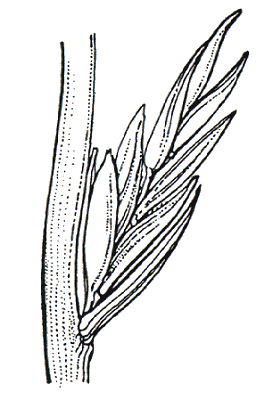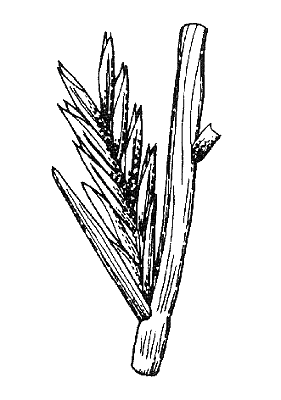Lolium perenne* Linn. Sp. Pl. 1: 83 (1753).
Classification. (GPWG 2001) : Subfamily Pooideae. Tribe Poeae.
Type of Basionym or Protologue Information: LT: Anon., (LINN-99.1). LT designated by Terrell, Techn. Bull. USDA 1392: 7 (1968). See also Loos & Jarvis, Bot. J. Linn. Soc. 108: 399–408 (1992) for a detailed discussion of the type..
Recent synonyms: L. perenne var. cristatum.
Key references (books and floras): [1878] G.Bentham, Flora Australiensis 7 (666), [1981] M.Lazarides in J.Jessop (ed)., Flora of Central Australia (430), [2002] D.Sharp & B.K.Simon, AusGrass, Grasses of Australia, [2002] J.Wheeler, N.Marchant & M.Lewington, Flora of the South West (422), [2006] J.Jessop, G.R.M.Dashorst, F.M.James, Grasses of South Australia (135), [2008] S.W.L.Jacobs, R.D.B.Walley & D.J.B.Wheeler, Grasses of New South Wales (297), [2009] A.Wilson (ed.). Flora of Australia, Vol 44A. Poaceae 2 (285), [1992] J.R.Wheeler et al, Flora of the Kimberley Region (288, Fig.38).
Illustrations: [1952] C.A.Gardner, Flora of Western Australia 1 Gramineae (191, Pl. 56), [1984] N.T.Burbidge. rev. S.W.L.Jacobs, Australian Grasses (177), [2006] J.Jessop, G.R.M.Dashorst, F.M.James, Grasses of South Australia (136, fig. 90), [2008] S.W.L.Jacobs, R.D.B.Whalley & D.J.B.Wheeler, Grasses of New South Wales, 4th edn (297).
Habit. Perennial. Culms erect or decumbent, stature slender to delicate, 24–90 cm tall. Lateral branches simple. Leaf-sheath auricles absent, or present. Ligule an eciliate membrane. Leaf-blades 3–20 cm long, 2–6 mm wide.
Inflorescence. Inflorescence solid, a spike. Racemes 1, 4–30 cm long, bearing 17–27 fertile spikelets on each.
Spikelets. Spikelets sessile. Fertile spikelets many flowered, with at least 2 fertile florets (4–14), comprising 4–14 fertile floret(s), with diminished florets at the apex, oblong, laterally compressed, 7–20 mm long.
Glumes. Glumes similar to fertile lemma in texture. Upper glume lanceolate or elliptic or oblong or ovate, 5–12 mm long, coriaceous, without keels, 3–7 -nerved. Upper glume surface smooth.
Florets. Fertile lemma 5–7 mm long, without keel, 5 -nerved. Lemma apex muticous. Grain 3.8–4 mm long.
Continental Distribution: Europe, Africa, Temperate Asia, Tropical Asia, Australasia, Pacific, North America, South America, and Antarctica.
Australian Distribution: Western Australia, South Australia, Queensland, New South Wales, Victoria, Tasmania, Norfolk I.
Western Australia: Drummond, Dale, Menzies, Warren, Eyre, Roe, Avon. South Australia: Flinders Ranges, Northern Lofty, Murray, Yorke Peninsula, Southern Lofty, Kangaroo Island, South-eastern. Queensland: Burnett, Cook, Darling Downs, Moreton, Wide Bay. New South Wales: North Coast, Central Coast, South Coast, Central Tablelands, Southern Tablelands, North-Western Slopes, South-Western Slopes, North-Western Plains. Victoria: East Gippsland, Eastern Highlands, Gippsland Highlands, Gippsland Plain, Grampians, Lowan Mallee, Midlands, Murray Mallee, Otway Plain, Otway Range, Wilsons Promontory, Riverina, Snowfields, Volcanic Plain, Wannon, Wimmera. Tasmania: No region given.
Notes. Cultivated for pasture.
A variable species with numerous morphological forms. In the northern hemisphere some of these have been recognised at various subspecific ranks, but here a broader sense of the species is recognised.
Introduced. All states and territories except N.T. Indigenous in parts of Europe, Asia and presumably north Africa, widely introduced and now throughout temperate regions of both hemispheres. Naturalised throughout the higher rainfall temperate areas, commonly in fields, waste places and roadsides. Flowers Aug.-Feb.







